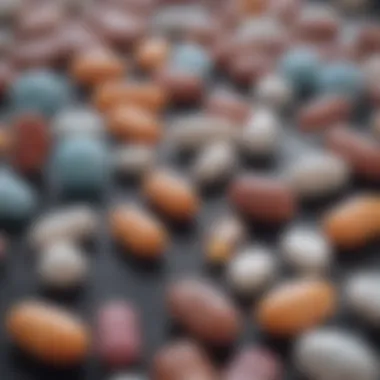Comprehensive Insights into Gouty Arthritis Treatment


Intro
Gouty arthritis, often referred to simply as gout, is a form of inflammatory arthritis characterized by sudden and severe pain, redness, and swelling in the joints. The condition is primarily linked to the accumulation of urate crystals within the joints, resulting from elevated levels of uric acid in the blood. This article aims to provide a thorough understanding of the pharmacological management of gouty arthritis, offering insights into the types of medications available, their mechanisms of action, and possible side effects. Furthermore, the discussion isn't limited to pharmacotherapy; it also encompasses non-pharmacological strategies, lifestyle modifications, and the latest research developments in the field.
In laying the groundwork for this exploration, it's vital to define some key concepts and terminologies that will be central to our discussion.
Key Concepts and Terminology
Definition of Key Terms
To navigate through the complex landscape of gouty arthritis treatment, certain terms need clarification:
- Gout: A type of arthritis that causes sudden, severe attacks of pain, swelling, and redness in the joints.
- Uric Acid: A waste product formed from the breakdown of purines; high levels can lead to gout.
- Hyperuricemia: A condition characterized by excess uric acid in the blood, often a precursor to gout.
- Anti-inflammatory Medications: Drugs used to reduce inflammation and relieve symptoms.
Concepts Explored in the Article
This article seeks to unravel several pertinent concepts:
- Pharmacological Treatments: Examining various medications, including nonsteroidal anti-inflammatory drugs (NSAIDs), corticosteroids, and urate-lowering therapies.
- Mechanisms of Action: The underlying biological processes through which these medications exert their effects.
- Lifestyle Modifications: How diet and lifestyle choices can influence gout management.
- Emerging Research: Current studies exploring novel treatment strategies and their implications.
Findings and Discussion
Main Findings
The understanding of gouty arthritis has evolved significantly over the years, and recent findings illuminate several critical points:
- Tailored Pharmacotherapy: Effective management may require a combination of medications tailored to individual patient profiles.
- Importance of Lifestyle Changes: Diet plays a significant role in managing uric acid levels; foods high in purines, such as red meat and shellfish, should be limited.
- Role of Chronic Conditions: Patients with comorbidities like renal diseases often face challenges in treatment and require specialized management approaches.
"Managing gout involves not just medications, but also a comprehensive approach that incorporates lifestyle adjustments and understanding the patient’s overall health status."
Potential Areas for Future Research
While significant strides have been made in gout management, certain gaps remain that warrant further investigation:
- Long-term Safety of Medications: Ongoing studies to assess the long-term effects of urate-lowering therapies on kidney function and cardiovascular health.
- Impact of Diet on Medication Efficacy: Research into how dietary modifications can enhance the effectiveness of pharmacological interventions.
- Genetic Predisposition Studies: Exploring how genetics may influence an individual’s response to treatment and susceptibility to gout.
Understanding Gouty Arthritis
Gouty arthritis may seem like a niche topic within the broader spectrum of medical conditions, but understanding it is crucial for both patients and healthcare professionals. This form of arthritis is centered around elevated levels of uric acid in the bloodstream, leading to sharp crystals forming in the joints. These episodes can be not just painful, but also damaging to the joints over time. By grasping the characteristics and implications of gout, those impacted can better manage their conditions and avoid the pitfalls that accompany this ailment.
Definition and Characteristics
Gouty arthritis, often simply referred to as gout, is characterized primarily by sudden and intense inflammation in joints, often starting with the big toe. It can feel as if someone is squeezing your joint with a vise – the pain is severe. This condition arises from the body's inability to rid itself of uric acid, a waste product formed when the body breaks down purines, substances found in certain foods and beverages.
The presence of urate crystals in joint fluids is often what ignites the inflammation. This occurrence can happen at any time, but it frequently does so at night, creating a sense of urgency in seeking treatment. Gout can manifest in acute attacks, and if left unchecked, it may develop into a chronic condition, complicating both mobility and quality of life.
Epidemiology and Risk Factors
The epidemiology of gouty arthritis reveals significant insights into who gets this condition and why. The incidence of gout has been notably increasing in recent decades, particularly among older men and postmenopausal women. Studies point out that certain demographics are at a higher risk, including:
- Age: Gout typically strikes later in life, especially in those over 40.
- Gender: Men are more susceptible than women, possibly due to hormonal differences in uric acid metabolism.
- Obesity: Excess body weight contributes to higher uric acid production.
- Dietary Choices: Consumption of red meat, seafood, and sugary beverages can elevate risk.
Moreover, a family history of gout can play a role in an individual’s likelihood of developing the condition. Furthermore, certain medical conditions such as kidney disease or hypertension increase vulnerability.


Pathophysiology of Gout
The pathophysiology of gout is quite intricate, involving a multifaceted interplay of genetic, dietary, and environmental factors. Uric acid, when in excess, precipitates as monosodium urate crystals in synovial fluid surrounding the joints. This leads to the activation of the immune response, where macrophages attempt to phagocytize the crystals but instead contribute to a local inflammatory response.
Understanding this mechanism reveals why sudden spikes in uric acid levels can trigger acute gout flares. The immune system's heightened response to these crystals is akin to a fire alarm going off in response to smoke – it’s a swift and often overwhelming reaction. Over time, chronic inflammation from recurring gout attacks can lead to a more permanent joint damage, manifested by tophi formations under the skin and decreased joint functionality.
"Understanding the nuances of what could trigger gout attacks empowers individuals to make informed choices that can drastically affect their quality of life."
In summary, a deep dive into gouty arthritis reveals the importance of recognizing its definition and characteristics, understanding the epidemiological footprint of the disease, and exploring the pathophysiological mechanisms at play. This foundational knowledge serves as a backbone for developing effective treatment strategies, as the road to managing gouty arthritis is paved with informed decisions.
Role of Medication in Managing Gout
Managing gout, especially during an acute flare, often requires an arsenal of medications. The role of these medications cannot be overstated; they are pivotal in alleviating pain, reducing inflammation, and maintaining lower uric acid levels in the body. While it is important to understand the comprehensive treatment plan, the focus here is keenly on medication, which serves as the backbone of clinical management in gouty arthritis. A well-structured medication regimen not only helps in active treatment but also plays a critical role in long-term management and prevention of future attacks.
Types of Medications Available
NSAIDs
Nonsteroidal anti-inflammatory drugs (NSAIDs) stand as a frontline defense against gout pain. Medications like naproxen or indomethacin are often prescribed, providing rapid relief of pain and swelling during an acute flare.
A key characteristic of NSAIDs is their anti-inflammatory properties. They work by inhibiting the production of substances in the body that cause inflammation and pain. This makes them a popular choice among healthcare providers because they work relatively quickly to ease discomfort.
However, NSAIDs are not without drawbacks. Long-term use can lead to gastrointestinal issues and kidney problems. Still, for short-term relief, their unique blend of efficacy and accessibility makes them a reliable option for patients.
Corticosteroids
Corticosteroids like prednisone serve a different niche in managing gout. These potent anti-inflammatory agents are particularly useful for patients who cannot tolerate NSAIDs or when rapid relief is necessary.
Their primary characteristic lies in their ability to suppress the immune response, thereby minimizing inflammation effectively. Patients often find corticosteroids beneficial, especially during severe flare-ups.
But, as with any powerful medication, there are nuances to consider. Long-term use can lead to side effects, including weight gain, mood changes, and increased risk of infection. Thus, corticosteroids tend to be a secondary option, mainly reserved for acute situations.
Colchicine
Colchicine has a reputation in gout management that is both historical and contemporary. This medication is particularly effective in preventing gout attacks and alleviating symptoms during an acute episode.
One of its crucial features is its mechanism of action; colchicine interferes with the inflammatory response to uric acid crystals, thus offering relief. As such, it is a beneficial choice for patients suffering from recurrent flares.
Nevertheless, colchicine can have gastrointestinal side effects, such as diarrhea, which may deter some patients. The fine line of dosage needs careful management, considering these nuances in how it interacts uniquely with the body’s systems.
Urate-Lowering Therapies
When managing chronic gout, urate-lowering therapies like allopurinol or febuxostat become indispensable. These medications function by reducing the levels of uric acid in the body, addressing the root cause of gout rather than just alleviating symptoms.
A vital characteristic of these therapies is their long-term effectiveness in preventing future attacks. By maintaining uric acid levels within a target range, these medicines are considered beneficial for individuals prone to frequent gout episodes.
However, initiating urate-lowering therapies should be approached cautiously, as they can occasionally provoke acute gout flares when first introduced. Thus, careful monitoring is essential when starting treatment.
Mechanisms of Action
Understanding how each of these medications works is crucial for optimizing treatments. NSAIDs inhibit the enzymes responsible for pain and swelling, corticosteroids suppress overall inflammation, colchicine targets the inflammatory pathways linked to gout, and urate-lowering therapies limit uric acid production or enhance its excretion. Each mechanism directly aligns with the need to manage both acute flares and chronic conditions.
Indications for Use


The choice of medication significantly correlates with the patient’s specific circumstances. NSAIDs are typically favored in acute phases, while corticosteroids serve as alternatives for those unable to tolerate NSAIDs. Colchicine is used both for flare management and as a preventive measure, and urate-lowering therapies integrate into long-term management plans. By tailoring these medications to individual needs, healthcare providers can craft an effective, personalized treatment strategy to combat gout.
Pharmacological Management Strategies
Medication plays a pivotal role in managing gouty arthritis. The objective of pharmacological strategies is twofold: to alleviate acute symptoms during flares and to manage the underlying condition over the long term. This dual approach is crucial, as uncontrolled levels of uric acid lead not just to joint pain but to potential long-term damage. By tailoring treatment to individual patient needs, healthcare professionals can achieve optimal outcomes that minimize flare-ups while preserving joint function.
Acute Gout Flare Treatment
During an acute gout flare, the immediate goal is to relieve the intense pain and inflammation. Nonsteroidal anti-inflammatory drugs (NSAIDs) are often the first line of defense. Medications like indomethacin or naproxen are commonly used since they help reduce swelling and relieve pain effectively.
- Dosage and Administration: Patients are usually advised to take these medications as soon as symptoms appear. In most cases, using them as per the doctor’s guidance ensures better relief.
- Alternative Options: If NSAIDs don’t do the trick or if there are contraindications, corticosteroids can be very effective. They act quickly to control inflammation. Colchicine, another option, is particularly known for its efficacy when taken early in the onset of a flare. Its primary mechanism involves disrupting the inflammation caused by uric acid crystals, thus offering significant relief.
Ultimately, treatment during an acute flare is about timely intervention. The faster the response, the better the outcome.
Long-Term Management of Hyperuricemia
Beyond flares, managing hyperuricemia is fundamental for lasting relief from gout symptoms and preventing future attacks. Urate-lowering therapies must be the cornerstone of long-term strategies.
- Allopurinol is often prescribed as the go-to medication. It works by inhibiting xanthine oxidase, an enzyme essential for uric acid production. This helps in maintaining lower uric acid levels effectively. Regular blood tests are necessary while on this medication to monitor uric acid levels.
- Febuxostat is another alternative which operates similarly to allopurinol but may be better tolerated in some patients. It offers a different pathway for managing uric acid without some of the side effects associated with older therapies.
Lifestyle Adjustments: It's essential to note that medication alone isn't the be-all-end-all. Long-term management often includes lifestyle modifications, such as dietary choices and weight management, which can further assist in controlling uric acid levels.
In this context, pharmacological management of gouty arthritis revolves around a spectrum of choices—each tailored to patient-specific needs, emphasizing that effective management is a marathon, not a sprint.
Benefits and Risks of Medications
Understanding the benefits and risks associated with medications for gouty arthritis is paramount. Effective management of this condition hinges on a delicate balance between harnessing the benefits of specific drugs while remaining cognizant of their potential drawbacks. The medications prescribed can alleviate pain and lower uric acid levels, essentially offering a lifeline to patients suffering from severe flare-ups. However, a cautious approach is necessary as various side effects and individual responses to these treatments can significantly impact a patient’s overall health and quality of life.
Efficacy of Medications
When considering the efficacy of medications for gouty arthritis, one must delve into how these treatments actually work in the body. Various classes of drugs play distinct roles in managing this condition:
- Non-Steroidal Anti-Inflammatory Drugs (NSAIDs): These are typically the first line of defense during an acute gout attack, providing significant relief from pain and inflammation. Examples include ibuprofen and naproxen which, for many, serve as a go-to remedy.
- Colchicine: Known for its ability to reduce gout flare severity when taken promptly, colchicine helps in decreasing inflammation. This medication, however, requires careful dosing, especially in elderly patients or those with renal impairment.
- Urate-Lowering Therapies (ULT): Medications such as allopurinol and febuxostat are vital for long-term management. They work by lowering blood uric acid levels, which aim to reduce the frequency of attacks or prevent them entirely.
Though these medications can be potent in alleviating symptoms and preventing future outbreaks, the choice of which to prescribe often depends on the patient's medical history, age, and overall health. Studies indicate that with the right approach, many patients experience a marked improvement in their quality of life and fewer incidents of gout attacks.
"Every gout flare treated well today can lead to fewer struggles tomorrow, but every choice must be made with caution."
Potential Side Effects
As beneficial as medications can be, the flipside is that they can also pose a range of side effects. It’s essential to recognize these potential issues:
- Gastrointestinal Issues: For NSAIDs, patients may face stomach upset, ulcers, or increased bleeding risks. Monitoring is key, especially for individuals with existing stomach or liver problems.
- Kidney Function: Certain medications like allopurinol can lead to slight elevations in creatinine levels or, in rare cases, acute kidney injury. Regular screening is advised to manage this risk effectively.
- Allergic Reactions: Some patients may experience adverse reactions to medications like colchicine, ranging from itchy rashes to severe conditions such as anaphylaxis, although the latter is rare.
- Drug Interactions: Since gout medication often interacts with others a patient might take, careful evaluation of a patient’s medication list is critical to avoid any unwanted complications.
In summary, while medications play a crucial role in managing gouty arthritis effectively, it's equally vital to remain informed about their potential side effects. Regular communication between patients and healthcare providers can ensure the right choices are made to maximize benefits while minimizing risks.
Non-Pharmacological Approaches
When managing gouty arthritis, it's crucial to look beyond just medications. Non-pharmacological approaches can play a significant role in reducing symptoms and preventing flare-ups. These methods provide a holistic angle that complements medical treatments, often focusing on lifestyle and dietary changes. The catch is that managing gout effectively is not solely about a pill bottle; it’s about understanding the broader lifestyle context. These changes can enhance the effectiveness of medications, improve overall quality of life, and potentially reduce the frequency of debilitating attacks.
Dietary Modifications
Diet plays a vital role in gout management. Certain foods can elevate uric acid levels, which can trigger flare-ups, making dietary awareness paramount. Foods rich in purines, such as red meats, organ meats, and certain seafood, can be particularly troublesome. The objective here is often twofold: to reduce the intake of those troublesome foods and to introduce more beneficial ones into the diet.


Key Dietary Changes to Consider:
- Hydration: Increased water intake can help the kidneys flush uric acid more efficiently and reduce its concentration in the blood.
- Fruits and Vegetables: Cherry juice, in particular, has been linked to lower uric acid levels. Other fruits like berries and low-fat yogurt are also beneficial.
- Whole Grains: Instead of refined grains, opting for whole grains can support overall health while possibly helping to keep the body’s uric acid levels in check.
- Lean Proteins: Limiting red meat and opting for lean poultry or plant-based proteins can also help lower the risk of flare-ups.
"Dietary changes can be simple but impactful. Watch what goes in your mouth, and it can save you a world of hurt later."
By nurturing a balanced diet and being mindful of food choices, individuals can better manage their uric acid levels. Knowing what to eat allows for smarter choices that can prevent the unwelcome surprise of a gout flare.
Exercise and Lifestyle Changes
In addition to dietary adjustments, incorporating regular exercise and adopting healthy lifestyle habits can significantly benefit those with gouty arthritis. Engaging in physical activity helps manage weight, which is an essential factor since obesity is a risk factor for high uric acid levels.
Benefits of Regular Exercise:
- Weight Control: Maintaining a healthy weight can lower uric acid levels and reduce the risk of attacks.
- Joint Mobility: Low-impact exercises such as swimming, walking, or cycling can improve joint function, helping keep them flexible and reducing the likelihood of injury.
- Stress Relief: Regular physical activity can also alleviate stress, which may contribute to the frequency of gout flare-ups. Activities like yoga or tai chi can enhance mental well-being and physical health simultaneously.
Furthermore, making lifestyle changes that promote overall health is equally important. Factors such as limiting alcohol intake, particularly beer and spirits, reducing stress levels, and obtaining adequate sleep are all crucial.
In sum, a combination of smart dietary choices and consistent physical activity can lead to an overall improvement in managing gout. Individuals who take a hands-on approach to their lifestyle may find themselves facing fewer attacks and living a more fulfilling life.
Current Research and Future Directions
Research on gouty arthritis is gaining momentum, reflecting an increasing recognition of its complexities and the need for innovative approaches to manage this chronic condition. The landscape of gout treatment is evolving, fueled by advanced scientific inquiries and a deeper understanding of the underlying mechanisms. This section explores some of the emerging trends and research directions that promise to shape the future of gout therapy.
Emerging Therapies
The current tide of innovation in gout management is marked by several emerging therapies that could change the game. One prominent area of focus is the development of monoclonal antibodies that specifically target key pathways involved in the inflammatory response associated with gout. These therapies aim to disrupt the vicious cycle of inflammation without the side effects commonly seen with traditional medications. For example, canakinumab, an interleukin-1 beta inhibitor, has shown promise in reducing flare-ups and managing symptoms effectively, but further studies are necessary to fully assess its long-term efficacy and safety.
Another interesting area involves the use of new oral medications that serve as urate-lowering therapies. Lesinurad, for instance, works by enhancing the excretion of uric acid through the urine, and has been shown to improve the effectiveness of existing urate-lowering drugs. This approach not only seeks to alleviate symptoms but also aims to prevent recurrent flares, thereby reducing the overall intensity of the disorder.
"Innovative treatments such as biologics and targeted therapies herald a new dawn in gout management, combining safety with efficacy.”
Clinical Trials and Innovations
Looking ahead, clinical trials play a crucial role in determining the viability and applicability of these emerging therapies. Ongoing studies are exploring not only newer medications but also alternative delivery methods, such as transdermal patches or sustained-release formulations, to enhance patient compliance and experience.
Significantly, many of these trials are designed with diverse populations in mind, considering ethnic backgrounds or comorbid conditions that may influence treatment outcomes. Furthermore, research is delving into the genetic factors underlying gout susceptibility. Insights gained in this arena of pharmacogenomics could lead to more personalized treatment regimens, tailored to individuals based on their genetic profiles.
To keep pace with these advancements, collaboration among research institutions, healthcare professionals, and pharmaceutical companies is more important than ever. By iteratively assessing the effectiveness of new treatments in real-world settings through observational studies, emerging insights can potentially lead to the refining of existing standards of care. Not to mention, the rapid advancement in technology allows telehealth to bridge gaps in patient participation, making it easier for individuals to engage in clinical trials without geographical constraints.
Closure
The conclusion of this article emphasizes the essential components related to the pharmacological management of gouty arthritis. As such, it helps bridge the insights offered throughout the sections, providing clarity and actionable knowledge. Understanding the complex nature of medications and their specific purposes allows patients and healthcare professionals alike to make informed decisions.
In summary, a thorough grasp of gout treatment—covering acute management, medication types, benefits, and risks—helps not just in mitigating pain but also in preventing future flare-ups. Gout is not merely a fleeting ailment; it requires ongoing management that involves both pharmacological and non-pharmacological approaches. Integrating these facets leads to a more holistic view of patient care.
The implications of this knowledge are vast and have far-reaching effects. By recognizing how each medication works and its place within a comprehensive treatment strategy, practitioners can tailor their recommendations based on the unique needs of each patient, highlighting the importance of personalized medicine in arthritis care.
"A deep understanding of treatment strategies can transform patient outcomes, ensuring a better quality of life."
Additionally, the landscape of gout management is always evolving. With emerging therapies and ongoing research promising more effective treatments, staying updated is paramount. Thus, healthcare providers, researchers, and patients must remain vigilant and open to adopting new strategies as they arise.
Summary of Key Points
- Gouty arthritis requires a multifaceted treatment approach, balancing medications and lifestyle changes.
- Understanding the mechanisms of various medications—such as NSAIDs, corticosteroids, and urate-lowering therapies—improves patient compliance and outcomes.
- Monitoring and managing potential side effects helps mitigate risks associated with medication, which is crucial for long-term success.
- Staying informed on emerging therapies enhances treatment options and informs patient care.
Implications for Practice
- Individualized Treatment Plans: Each patient presents unique challenges; therefore, customizing medication routes based on individual health profiles leads to better outcomes.
- Patient Education: Informing patients about their condition and the medications prescribed fosters compliance and enables proactive management of gout flare-ups.
- Interdisciplinary Approach: Collaborating with dietitians or physical therapists can complement pharmacological treatments and promote a balanced lifestyle.
- Continued Learning: Healthcare providers must engage in ongoing education regarding evolving treatment paradigms, ensuring that they apply the latest evidence-based practices in their care.
By synthesizing the principles of medication management with practical approaches in lifestyle modification, healthcare professionals can deliver a comprehensive treatment framework, ensuring that patients with gouty arthritis can lead not just manageable lives, but fulfilled ones.







